Of the 54 snake species living in Louisiana, only 7 are venomous. The state of Louisiana has 3 rattlesnakes, a copperhead, a cottonmouth, and 2 coral snakes. Below, we will talk about each of these snakes, what they look like, and where they live in Louisiana.
- Canebrake Rattlesnake (Crotalus horridus)
- Western Pygmy Rattlesnake (Sistrurus miliarius streckeri)
- Eastern Diamondback Rattlesnake (Crotalus adamanteus)
- Eastern Copperhead (Agkistrodon contortrix)
- Northern Cottonmouth (Agkistrodon piscivorus)
- Harlequin Coral Snake (Micrurus fulvius)
- Texas Coral Snake (Micrurus tener)
Pit Vipers
Rattlesnakes, Copperheads, and Cottonmouths belong to the venomous Viperidae or pit viper family. Another name for these snakes is pit vipers. Pit vipers have heat-sensing pits between their nostrils and eyes. These pits are actually specialized organs that detect infrared radiation from prey animals. Pit organs enable pit vipers to strike their prey precisely, even in the dark. They are also able to detect body heat from about 1 meter away.
These snakes also have spade-shaped heads. Furthermore, they have elliptical pupils that are vertical slits. This is a defining characteristic because a non-venomous snake generally has round pupils. The exception to this is the coral snake, which also has round pupils.
Pit vipers have hollow fangs connected to venom glands. They use their fangs to inject venom into their prey. This venom immobilizes the prey, making it easier for the snake to consume. They primarily consume small mammals, reptiles, amphibians, and small birds. These snakes play an important role in maintaining balance in rodent populations.
Rattlesnakes
The first thing people think about with regard to Rattlesnakes is their tails. When they are disturbed, they vibrate their tails. This makes a buzzing or a rattling-type sound. Sometimes, rattlers strike without rattling. Sometimes, their rattles fall off. You must be aware of where you are placing your hands and feet when you’re in rattlesnake country. If you hear a rattling noise, do not move until you spot where it originated. Otherwise, you may accidentally move into the snake, provoking it to strike you.
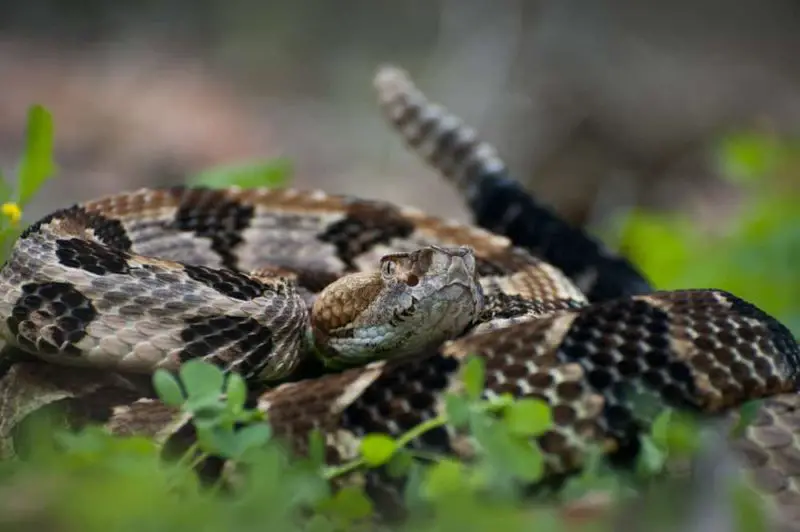
Canebrake Rattlesnake
| Scientific Name: | Crotalus horridus |
| Description: | Adult Canebrake Rattlesnakes grow between 36 and 60 inches (.91 to 1.52m) long. Their bodies are yellowish-brown with a dark chevron pattern. They also have a rusty stripe down their backs. Their tails are dark brown or black. |
| Habitat: | Canebrake Rattlesnakes prefer wooded areas and hillsides with rocky outcroppings. |
| Conservation Status: | Distributed throughout the state of Lousiana. |
Timber Rattler and Canebrake Rattlesnake are both common names for the Timber Rattlesnake. Generally, in higher-elevation habitats, they are called Timber Rattlesnakes. On the coastal plain, though, they’re called Canebrake Rattlesnakes. In Louisiana, they are called by both names.
The average Canebrake Rattlesnake grows between 36 and 60 inches (.91 and 1.52m) long. However, there have been reports of them growing up to 7 feet (2.13m) long. See
These snakes vary in color. Their general base coloration is a yellowish-brown to grey-brown, though. They have a dark brown to black chevron pattern on their back and sides against a lighter base color. Moreover, they have a rusty to reddish stripe down their backs. Their tails are dark brown or black. There are also melanistic timber rattlers. These are dark and sometimes almost entirely black. In the dark color morph of these snakes, the tail is still darker than the rest of the snake’s body.
Where Do Canebrake Rattlesnakes Live in Louisiana?
Canebrake Rattlesnakes live throughout most of Louisiana. However, they do not occur in the coastal swamps.
The Canebrake rattlesnake lives in various habitats. These include mountainous forests, pine forests, swamps, farm fields, and river floodplains. In the winter, they are found hibernating in crevices in the ground. These snakes are marvelous climbers and have been found in trees at heights of more than 80 feet. Source
What Do Canebrake Rattlesnakes Eat?
Canebrake Rattlesnakes prey on small mammals such as mice, rats, squirrels, and chipmunks. They also eat small birds, other reptiles, and amphibians.
These snakes are excellent climbers. In fact, timber rattlers have been found in trees at heights of more than 80 feet. Source
Experts have proven that timber rattlesnakes help control Lyme disease. This is because as they consume rodents, they’re also consuming ticks. A timber rattler will consume 2,500 to 4,500 ticks per year, depending on the location. See
What Eats Canebrake Rattlesnakes?
There are several potential predators of Canebrake Rattlesnakes in Louisiana. These include the Eastern Milk Snake, Black Racers, king snakes, skunks, and bobcats.
Wintertime Brumation
As we discussed in the section on copperheads, snakes brumate in the winter. Brumation is a reptile’s version of hibernation.
Timber Rattlesnakes make wintertime dens in sheltered spots. They den underneath rocks and logs, as well as in fissures in rocky hillsides. An individual Timber Rattler might brumate alone in some parts of their range. But in other areas, they congregate in dens with other snakes through the winter.
Dens are usually placed on slopes facing south because they get more warmth from the sun. They don’t always share their dens only with Timber Rattlers. Sometimes, they share their dens with other species of snakes. These might include Copperheads, Black Rat Snakes, and Eastern Black Racers. These wintertime dens may hold up to 60 snakes.
How Dangerous Are Canebrake Rattlesnakes?
Among venomous species of snakes, Timber Rattlesnakes are one of the most dangerous. This is due to their long fangs and high venom yield. 1% to 10% of untreated Timber Rattlesnake bites result in a fatality.
Fortunately, 40% to 60% of the time, they produce dry bites. In other words, although their fangs penetrate the body, they do not inject any venom. Source
These snakes produce hemotoxic venom. Timber Rattlesnake bites sometimes cause serious complications. These include shock, seizures, coma, internal bleeding, and deep tissue damage. Source
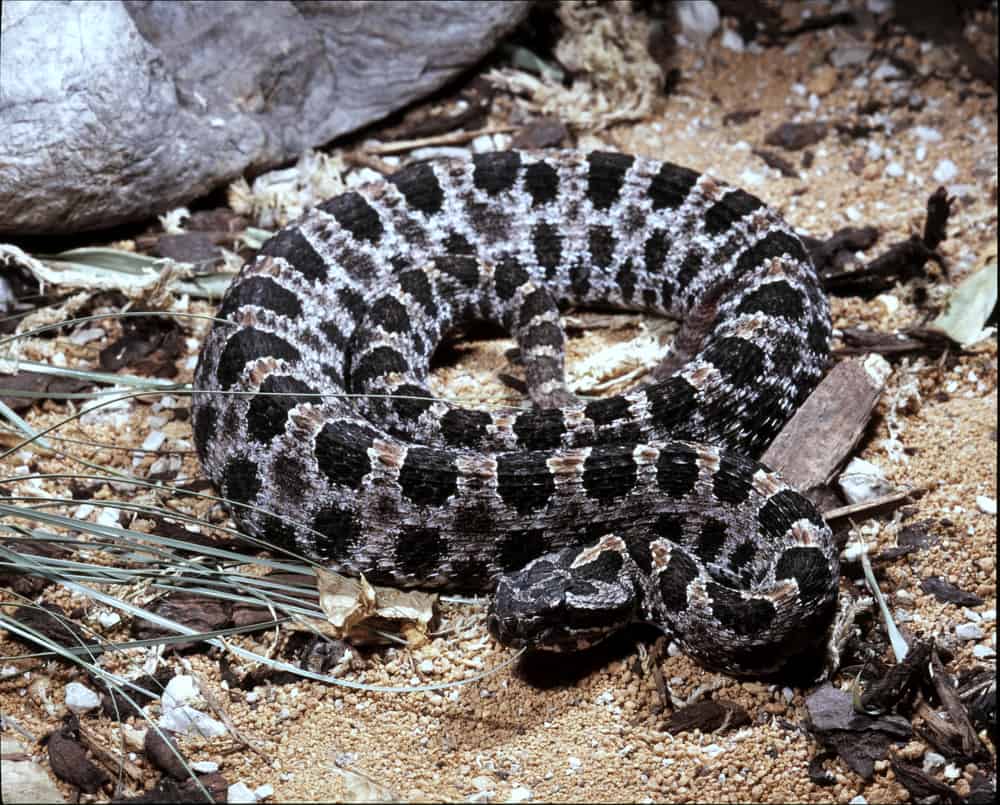
Western Pygmy Rattlesnake
| Scientific Name: | Sistrurus miliarius streckeri |
| Description: | Adult Western pygmies are 16 to 25 inches (.41 to .64m) long. Their bodies are light gray overlayed with dark blotches. A rust-colored stripe runs along its spine. |
| Habitat: | They inhabit sandhills, mixed forests, and floodplains. They also live near marshes and lakes. |
| Conservation Status: | Distributed throughout the state of Louisiana. |
The Western Pygmy Rattlesnake is a small, slender-tailed snake with a tiny rattle. It grows in length between 16 to 25 inches (.41 to .64m). The base color of their body is light gray. Furthermore, they have a rust-colored stripe along their spine. (The stripe may be absent in some individuals.) They also have a series of dark blotches along their top and sides. Their cream-colored bellies are frequently mottled. They have a distinct, dark stripe that leads from the corner of their mouth to their eye. Their tiny rattle makes a faint grasshopper-like buzz that can only be heard from about a yard away.
Other common names for this snake are ground rattlesnake and pigmy rattlesnake.
Where Do Western Pygmy Rattlesnakes Live in Louisiana?
The Western Pygmy Rattlesnake is found scattered throughout the state of Louisiana. They inhabit sandhills, mixed forests, and floodplains. They are also located near marshes and lakes.
How Dangerous Are Western Pygmy Rattlesnakes?
The venom of the Western Pygmy Rattlesnake is cytotoxic. By definition, cytotoxic venom destroys the body’s cells. This venom disrupts blood flow and prevents clotting with its digestive enzymes. Luckily, these snakes produce a small venom yield. A bite from a pygmy rattlesnake is unlikely to be fatal. However, any bite victim should still receive prompt medical attention.
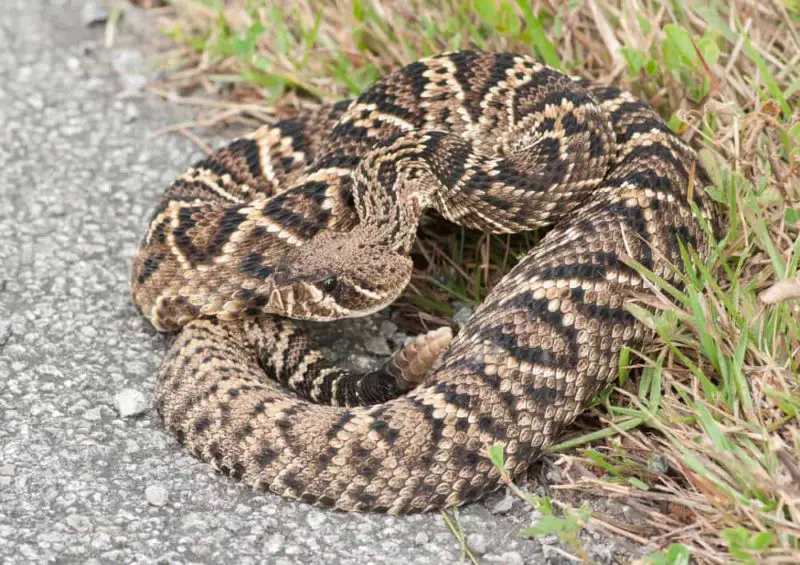
Eastern Diamond-backed Rattlesnake (Crotalus adamanteus)
| Scientific Name: | Crotalus adamanteus |
| Description: | Eastern Diamondback grows 3 to 6 feet (.91 to 1.83m) long. Their color is brownish-yellow, brownish-gray, or olive green. A brownish-black diamond-shaped pattern runs down their backs. |
| Habitat: | They prefer coastal forests, scrublands, and pine/wiregrass Flatwoods. |
| Conservation Status: | Ranked as S1 (critically imperiled) in Louisiana. The last recorded sighting in Louisiana was in 1985. |
The Eastern Diamondback rattlesnake is the largest venomous snake in the United States. These snakes average anywhere between 3 to 6 feet (.91 to 1.83m) long. Amazingly, though, the largest eastern diamondbacks reach 8 feet in length. In weight, they average anywhere between 5 to 10 pounds (2.27 to 4.54 kg).
Their base coloring varies between brownish-yellow, brownish-gray, or olive green. A brownish-black diamond-shaped pattern runs down their backs. Each of these diamond-shaped blotches is lined with a row of cream-colored scales. Towards the end of the snake next to the tail, these blotches turn into crossbands. Their bellies are a cream color with dark mottling along the sides.
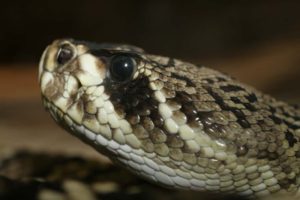
A black band extends from behind the eye and down towards the mouth. The band is outlined with white bands on either side.
Where Do Eastern Diamondbacks Live in Louisiana?
The Eastern Diamondback is found in Southeastern Louisiana.
They prefer coastal forests, scrublands, and pine/wiregrass Flatwoods. They can be found in moist areas such as wet prairies and savannas and around the wetlands’ borders. These snakes are proficient swimmers. They regularly swim between barrier reefs and along swamp edges. Source
Eastern Diamondback Rattlesnake Behavior
Eastern Diamondbacks take shelter in gopher, tortoise, and armadillo burrows. They emerge early in the morning or afternoon to bask in the sun. Occasionally, these snakes climb into bushes and trees, hunting for prey. Some have been spotted as high as 33 feet off the ground. Source
How Dangerous Are Eastern Diamondback Rattlesnakes?
Eastern Diamondbacks are one of the most dangerous snakes in North America. In fact, they chalk up more fatal bites than any other venomous snake in the United States. Source
Eastern Diamondback bites cause severe pain, edema, headache, nausea, dizziness, and convulsions. Their hemotoxic venom impairs blood coagulation. This may lead to severe internal bleeding, which may lead to kidney damage. Source.
You might also like:
Scorpions in Louisiana – Krebs Creek
Are There Bears in Louisiana? – Krebs Creek
Wild Cats in Louisiana – Krebs Creek
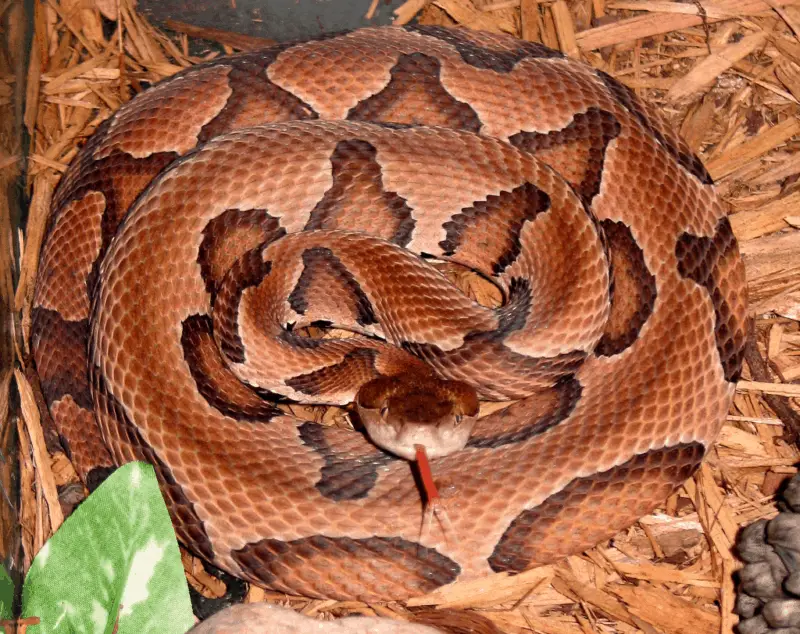
Eastern Copperhead
| Scientific Name: | Agkistrodon contortrix |
| Description: | Adult copperheads are 20 to 37 inches (50 to 95 cm) long. Their bodies are coppery brown overlayed with dark brown hourglass blotches. |
| Habitat: | Deciduous forests, river bottoms, and rocky wooded hillsides. |
| Conservation Status: | Copperheads are found throughout the state of Louisiana. Their populations are considered stable. |
The Eastern Copperhead is a pit viper native to the eastern United States. Louisiana was formerly home to the Southern Copperhead subspecies. However, DNA analysis shows little genetic difference between the two. Today the former Northern Copperhead, Southern Copperhead, and Osage Copperhead are taxonomically combined. The common name for these snakes is Eastern Copperhead. Their scientific name is Agkistrodon contortrix. Source
Eastern Copperhead snakes have reddish-tan to grayish-tan bodies. Their bodies are overlaid with hourglass-shaped dark brown markings. Their triangular heads are proportionately large. The color of their head is dark coppery brown. This is the reason they have the name “Copperhead.”
Copperheads are stout heavy-bodied snakes. Adult copperheads are 20 to 37 inches (50 to 95 cm) long.
Where Do Eastern Copperheads Live in Louisiana?
You will find the Eastern Copperhead throughout the state of Louisiana. They are found in river bottoms where the leaf and plant debris provide cover for them to hide. They are also, at times, located in wooded suburbs.
Eastern Copperhead Behavior
Copperheads are dangerous because they use camouflage as their number one defense mechanism. In other words, these snakes choose to lie perfectly still rather than flee most of the time. Their camouflage helps them blend in with leaf litter and other ground debris.
When they feel threatened, they occasionally mimic the tail vibration of a rattlesnake. But, in most cases, they choose to lie perfectly still.
Most copperhead bites on humans occur when the person steps on or near the snake.
Wintertime Brumation
Snakes do not tolerate cold winters very well. They are ectotherms, which means they cannot regulate their body temperature internally. Physiologically, ectotherms cannot hibernate. Yet, they go into a state of suspended animation called brumation for up to 6 months out of the year.
Copperheads winter underneath rocks, in hollow logs, and in fissures on rocky hillsides. An individual might brumate alone in some parts of their range. But copperheads tend to be social. In some areas, they congregate together in dens with other snakes through the winter.
In hilly terrain, south-facing slopes capture more radiant warmth from the sun. So, that is where these dens are generally located. The other snakes they den with are not necessarily just copperheads. Sometimes, they share their dens with other species of snakes. You may find a Timber Rattler, a Southern Black Racer, or a Black Rat Snake sharing the same den with copperheads. These wintertime dens may hold up to 60 snakes.
What Do Copperheads Eat?
Copperhead snakes are opportunistic feeders. They eat insects, spiders, frogs, small animals, birds, and other reptiles.
How Dangerous Are Copperheads?
A Copperhead can bite and inject venom from the time they are newly born. Like most pit vipers, they have hemotoxic venom.
Most copperhead bites are not life-threatening. On the other hand, any bite from this snake is a medical emergency and should be treated as such. Prompt medical attention increases the chance of a good outcome.
Copperhead bites can cause intense pain, shock, and swelling. Their bites also have the potential to cause blood in urine, tissue damage, and kidney failure.
An interesting study has found that Copperhead venom contains a protein called contortrostatin. Contortrostatin has been found to stop the growth of cancer cells in mice.
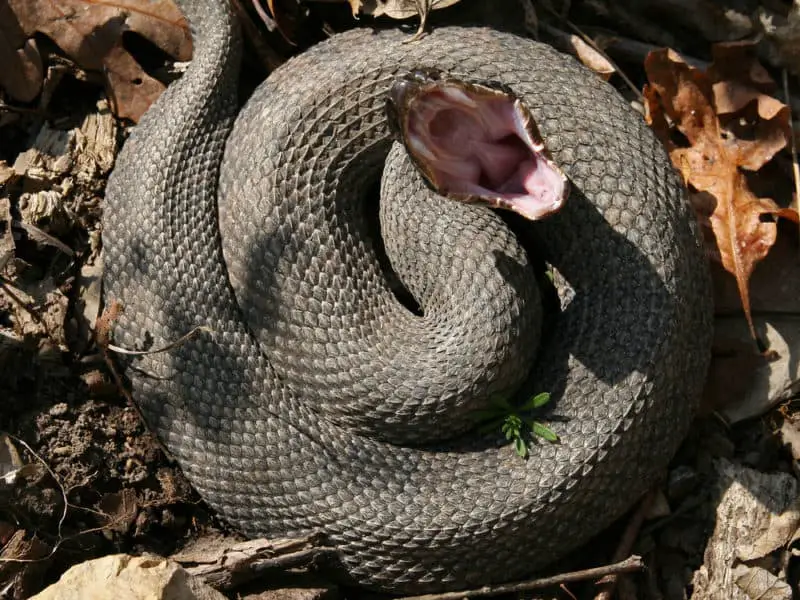
Northern Cottonmouth
| Scientific Name: | Agkistrodon piscivorus |
| Description: | These are stout, muscular snakes that grow up to 3 feet (.91m) long. The Northern Cottonmouth has a dark brown to black body with few markings. |
| Habitat: | Cottonmouths hang out near swamps, drainage ditches, slow-moving streams, and lakes. |
| Conservation Status: | Cottonmouths are found throughout the state of Louisiana. Their populations are considered stable. |
The cottonmouth population in Louisiana was formerly called Western Cottonmouths. However, DNA analysis shows little genetic difference between Eastern Cottonmouths and Western Cottonmouths. Today, the former Eastern Cottonmouth and Western Cottonmouth are taxonomically combined. The common name for these snakes is Northern Cottonmouth. Their scientific name is Agkistrodon piscivorus. Source Source
Another common name for the Northern Cottonmouth is water moccasin. These are stout, muscular snakes that grow up to 3 feet (.91m) long. They look a little bit like rattlesnakes without the rattle on the tail. People also sometimes mistake them for common water snakes. This could be a dangerous mistake.
The Northern Cottonmouth has a dark brown to black body with few markings. The inside of their mouth is white, hence the name “cottonmouth.” When threatened, they will pose with their mouth open. They have cat-like pupils, which appear as narrow slits in the day, and at night, they have a round appearance.
The juvenile cottonmouth has a more clearly defined pattern than adults. Their patterning resembles that of a copperhead. They have darker bands, though, that widen toward the belly and narrow at the back.
Where Do Northern Cottonmouths Live in Louisiana?
Northern Cottonmouths can be found throughout Louisiana. They are semi-aquatic snakes. They usually hang out near swamps, drainage ditches, slow-moving streams, and lakes. Interestingly, they can hold their breath underwater for up to an hour while hunting for prey. They commonly sun themselves on rocks or logs at the water’s edge. Cottonmouths sometimes venture overland. It’s not unheard of to see one far from any bodies of water. See
What Do Northern Cottonmouth Snakes Eat?
These snakes prey on fish, freshwater crustaceans, amphibians, small mammals, and other reptiles. Cottonmouths sometimes congregate around drying wetland pools to feed on any trapped fish.
How Dangerous Are Northern Cottonmouths?
Northern Cottonmouth venom is cytotoxic. This means it destroys body tissue. Northern Cottonmouth bites sometimes lead to the amputation of limbs. On rare occasions, death can occur. See
Their venom is cytotoxic and will destroy your body tissue if you are bitten. This can lead to amputation and, on rare occasions, death.
Coral Snakes
The first five snakes that we’ve talked about are pit vipers. Coral Snakes are not.
Coral snakes belong to the Elapidae family, along with Cobras and Mambas.
Like all elapid snakes, Coral Snakes have round pupils. They also lack the heat-sensing pit organs that pit vipers have.
Coral Snakes are egg-laying snakes. This is also different from Luisiana’s other venomous snakes, all of which give live birth.
Coral snakes are highly venomous snakes. In fact, herpetologists regard them as the most venomous snake in the United States. Fortunately, they almost never bite.
What Coral Snakes Look Like?
Coral Snakes are known for their vibrant and distinctive coloration. Most individuals have bands of red, yellow, and black. The pattern of these bands is consistent among most coral snakes in the United States. They have red and yellow bands touching each other, while the black bands separate them.
They have rounded heads and noses with similar-looking tails. Consequently, it is sometimes hard to tell a coral snake’s head from its tail.
Batesian Mimicry Of Coral Snakes
Batesian mimicry is a biological term. It describes how a harmless species protects itself by resembling a dangerous one. For example, the scarlet and eastern milk snakes are nonvenomous snakes. Yet, their color patterns closely resemble the venomous coral snake. The difference is that a coral snake’s red and yellow bands touch. On the other hand, the nonvenomous species’ color patterns are red, black, and yellow. Also, a coral snake’s head is blunt and entirely black, even behind its eyes, while a scarlet snake’s head is red.
This rhyme helps people distinguish between a nonvenomous species and a coral snake. “Red and yellow can kill a fellow; Red touch black, a friend of Jack.”
The rhyme is mostly accurate in the United States. However, coral snakes from areas south of the U. S. do not always follow the black-yellow-red pattern. This is true in Central America, South America, and the Caribbean.
Finally, there are rare coral snakes that do not follow the usual color pattern in the United States. Pink, cream-colored, light blue and completely black coral snakes exist in the wild.
How Dangerous Are Coral Snakes?
Coral snakes have neurotoxic venom. It is the second strongest of any snake. They’re less dangerous than Louisiana’s pit vipers, though. There are several reasons for this. First of all, coral snakes are docile. You’d have to grab one or accidentally step on it before it would try to bite you.
Next, they’re not constructed to envenomate you easily. Their smaller mouths and short fangs yield less venom. Thus, they have a less effective venom delivery system. Coral snakes must hold onto and chew their prey to allow the venom to flow into the wound.
People should take coral snake bites seriously, though. Before we had antivenom, the death rate after coral snake envenomation was around 10%. See
Coral snake bites differ from pit viper bites because there is little initial pain. Moreover, the neurotoxic venom’s effects may not set in for hours. When they come, they progress rapidly though.
Potential effects of coral snake envenomation include,
- muscle weakness
- difficulty speaking
- difficulty swallowing
- difficulty breathing
- Inability to move eyelids
- blurred vision
- twitching of the tongue
- paralysis
- respiratory failure
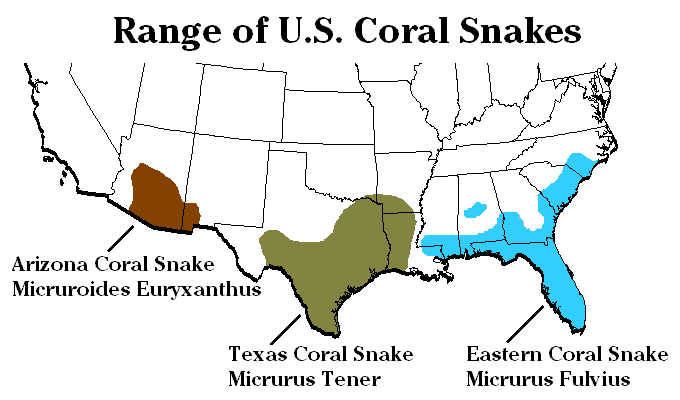
There are three different coral snake species native to the United States. The state of Louisiana is home to two of them. These are the Harlequin (Eastern) Coral Snake and the Texas Coral Snake.
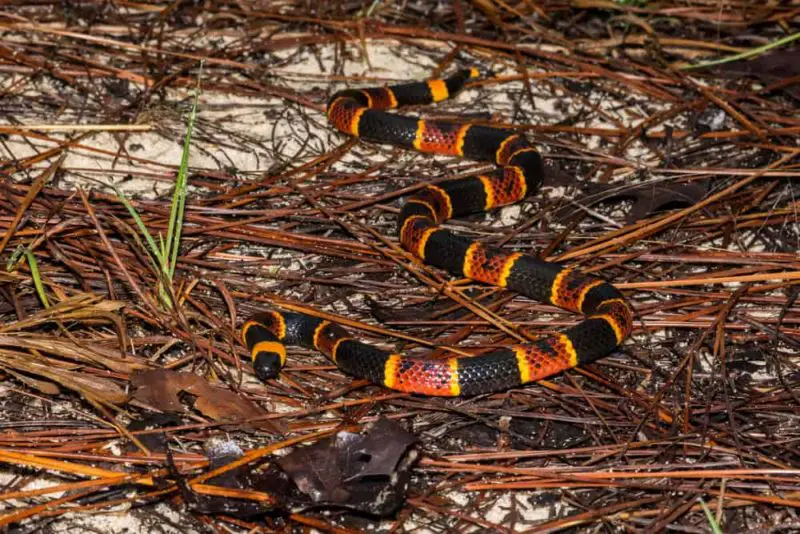
Harlequin Coral Snake
| Scientific Name: | Micrurus fulvius |
| Description: | Harlequin Coral snakes are up to 4 feet long (122 cm), but most grow to 2 feet (61 cm). They are ringed with red, yellow, and black bands. |
| Habitat: | Their habitat varies from dry, open, bushy areas to tropical hammocks. |
| Conservation Status: | Ranked as S2 (imperiled) in Louisiana. |
The Harlequin Coral Snake is also called the Eastern Coral Snake. They are called Harlequin Coral snakes in Louisiana. These snakes grow up to 4 feet long (122 cm), but most grow to 2 feet (61 cm). They are sexually dimorphic, with the males slightly smaller than the females.
Where Do Harlequin Coral Snakes Live in Louisiana?
These snakes are found throughout the eastern half of Louisiana. Their habitat varies from dry, open, bushy areas to tropical hammocks.

Texas Coral Snake
| Scientific Name: | Micrurus tener |
| Description: | Texas Coral snakes are around 24 inches (60 cm) long. Most are ringed with red, yellow, and black bands. |
| Habitat: | Wooded habitats |
| Conservation Status: | Ranked as S2 (imperiled) in Louisiana. |
An average adult Texas Coral Snake is around 24 inches (60 cm) long. However, some individual snakes are around twice that length. Source
They are sexually dimorphic, with the males slightly smaller than the females. As with Harlequin Coral Snakes, their heads look similar to their tails. Their general color pattern is also similar to Harlequin Coral Snakes. They have black, light yellow, and red bands, with the yellow bands separating the red and black. Some specimens that lack black and red pigments have been found in the wild, though. Some individuals are almost completely black, while others are more pastel in color.
Where Do Texas Coral Snakes Live in Louisiana?
These snakes are found in western Louisiana. They are diurnal snakes that prefer wooded habitats. They spend much of their time hiding in leaf litter on the forest floor.
General Symptoms of Venomous Snake Bites
Some of the symptoms you may experience when a venomous snake bites you include:
- Discoloration in the area of the bite.
- Swelling in the area of the bite.
- Loss of muscle coordination.
- Tingling sensation in the area of the bite.
- Feeling nauseous.
- Having a faster heartbeat or rapid pulse.
Symptoms of Venomous Snake Bites
Some of the symptoms you may experience when a venomous snake bites you include:
- Discoloration in the area of the bite.
- Swelling in the area of the bite.
- Loss of muscle coordination.
- Tingling sensation in the area of the bite.
- Feeling nauseous.
- Having a faster heartbeat or rapid pulse.
What Should You Do if You Are Bitten?
If you or someone you are with has suffered a venomous snakebite, time is of the essence. Because the sooner a victim receives antivenom, the less chance the venom in their body has to cause harm. In other words, it is important to seek immediate medical treatment.
Do not attempt to kill the snake for identification purposes. This gives the snake a chance to bite you again. Also, consider that severed snakeheads can still bite and envenomate and often do. If you have a phone, take a picture of the offending reptile. Otherwise, get started on your way to the nearest hospital.
First Aid for Snake Bite Victims
- Remain calm and limit your movements. Do not run. If you must hike back to a vehicle, do it calmly and deliberately. Put as little stress on your heart as possible.
- Keep the area of the snake bite below the heart level and never above the heart level. Keeping the bite below the heart level will reduce the venom’s flow. However, holding the bite above your heart level will increase the venom’s flow.
- Remove all constricting items such as bracelets, watches, or rings before swelling occurs.
- Remember that using a cold compress on a venomous snake bite is not advisable. The cold may cause the local blood vessels to constrict and spread the venom faster.
- You can wash the affected area like any other wound with soap and water.
- You may cover the bite area with a moist dressing to reduce the swelling.
- Get prompt medical treatment. Call the hospital to tell them a venomous snake has bitten you. So they can have antivenom ready to give you when you arrive.
- A person whom a venomous snake has bitten may go into shock. If this happens, lay them flat and cover them with a blanket.
Dressing for Snake Country
- High-top leather boots and long pants are both wise ideas.
- Also, wear loose-fitting denim. If there’s a gap before the snake’s fangs touch your skin, your chances of being envenomated are lower.
- In the absence of high-top leather boots, some people wear snake gaiters.
Recent Posts
The only venomous snakes in Washington State are Northern Pacific Rattlesnakes. The Northern Pacific Rattlesnake (Crotalus oreganus oreganus) is a sub-species of the Western Rattlesnake. Anyone...
Skunks are not classified as true hibernators. But they go into a state of torpor when the weather gets cold. Skunks are light sleep hibernators, along with opossums, bears, and raccoons. ...
